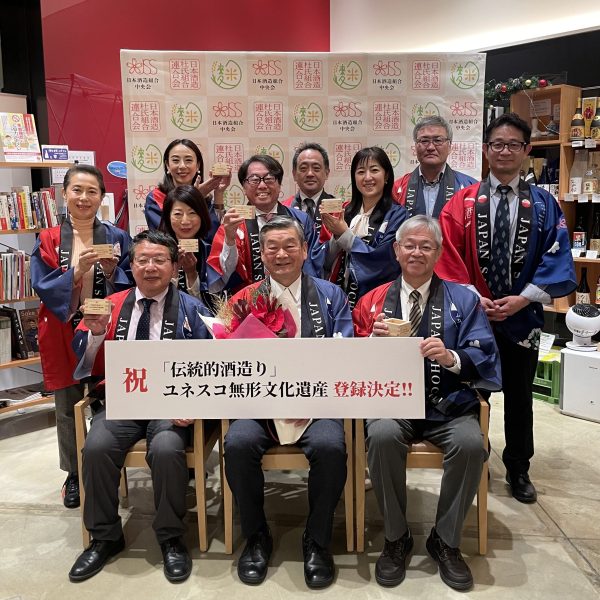
As soon as Japanese sake-making techniques (NB – sake in this context means the literal meaning of “all alcohol”) was granted UNESCO Intangible Cultural Heritage status I wanted to get something up on our website to provide some clarity. Lots of articles in the press are claiming sake itself has been granted status by UNESCO; the clue is in the name of the award, though: Intangible Cultural Heritage. So it’s the techniques and skills, honed over many years, that have been given this award.
On December 4, 2024, “Traditional Knowledge and Skills of Sake-making with Koji mold in Japan” (Japanese: 伝統的酒造り, “Traditional Sake-making”) was officially designated as a UNESCO Intangible Cultural Heritage (ICH). The designation includes not only sake but also shochu, awamori, and hon-mirin. This designation enshrines the knowledge and expertise of the head brewer, “toji,” leading a team of sake brewery workers, “kurabito,” in the production process of making sake, with special reference to the use of koji mould for starch to sugar conversion of raw materials, essential to the alcoholic fermentation process. Koji is not only used in alcoholic beverage making but also in other fermented foods such as miso, soy sauce, and vinegar. The designation of sake as a UNESCO ICH helps promote Japan as a nation with strong links to fermentation culture.
Since the 2003 Convention of Intangible Cultural Heritage began, Japan has had several elements of social practices, performing arts, and traditional craftsmanship inscribed on the Representative List at UNESCO. One of the more well-known inscriptions was “Washoku, traditional dietary cultures of the Japanese, notably for the celebration of New Year” in 2013. Under technical and legal assistance from the Agency for Cultural Affairs, sake craftspersons conducted a national survey to research the cultural aspects of the skills of sake-making and history. Such efforts of direct involvement and cooperation have led to the success of making sake-making a Registered Intangible Cultural Property (登録無形文化財) in Japan and, subsequently, the nomination of sake-making in UNESCO.
The registration criteria follow the Registered Intangible Cultural Property framework in enshrining the traditional knowledge and skills of sake-making. This includes three main parts of the sake production process:
(i) Processing raw materials for good conditions before sake-making
(remind yourself how sake is made here)
The technical aspects of sake-making alone would not be sufficient to elevate sake-making craftsmanship to the UNESCO level. The reasoning behind the inscription included a wider sociocultural context.
Japan Toji Guild Association and the Preservation Society of Japanese Koji-based Sake-Making Craftsmanship are the two leading nationwide organisations of craftspersons that coordinated for the designation. The Japan Toji Guild Association was formed in the 1960s by the different regional toji guilds across Japan. The Preservation Society of Japanese Koji-based Sake making craftmanship was established in 2021 (the same year when sake-making was made a Registered Intangible Cultural Property in Japan) to further safeguard and transmit traditional knowledge and skills of sake-making with koji mould. Both organisations were especially delighted to see the koji mould being included in the English title of the UNESCO designation to highlight the fundamental role of koji mould in Japanese cuisine.
The craftsmanship of the toji and the kurabito follows a distinct production method in achieving alcohol fermentation, predating modern scientific measurements’ application. Given the diverse climatic regions of Japan, their labour and expertise decide on the quality of sake by adjusting to the geographical limitations bound to them. The knowledge and skills passed on in various regions of Japan in different forms according to the local climate and environment demonstrate regional-specific knowledge in making sake.
Sake-making also involves a broader network of stakeholders, such as sake maker associations, research institutions, koji mould suppliers, farmers supplying the raw materials, and neighbouring residents. These stakeholders support sociocultural occasions in the community, such as festivals, weddings, religious rituals, etc., which further demonstrates the regional specificity in the importance of sake.
The success of putting sake-making on the UNESCO Cultural Intangible Heritage Representative List highlights the universal importance of traditional craftsmanship. This also means koji mould is finally under the spotlight, telling a global audience it is the star performing magic in the sake-making process. More importantly, by putting sake on a global conversation framework, more national and international resources will be put into preserving sake-making knowledge and expertise and the broader community in general. This milestone is not the end but the beginning of sake with greater global recognition.
UNESCO Cultural Intangible Heritage – https://ich.unesco.org/en/RL/traditional-knowledge-and-skills-of-sake-making-with-koji-mold-in-japan-01977#identification (Accessed 8 Dec 2024)
Nomination Form – 62695-EN (Accessed 8 Dec 2024)
Consent of communities – 59298 (Accessed 8 Dec 2024)
ICH Inventory – 59295 (Accessed 8 Dec 2024)
Wine Industry Advisor – https://wineindustryadvisor.com/2024/12/05/sake-making-with-koji-mold-is-unesco-intangible-cultural-heritage/ (Accessed 8 Dec 2024)